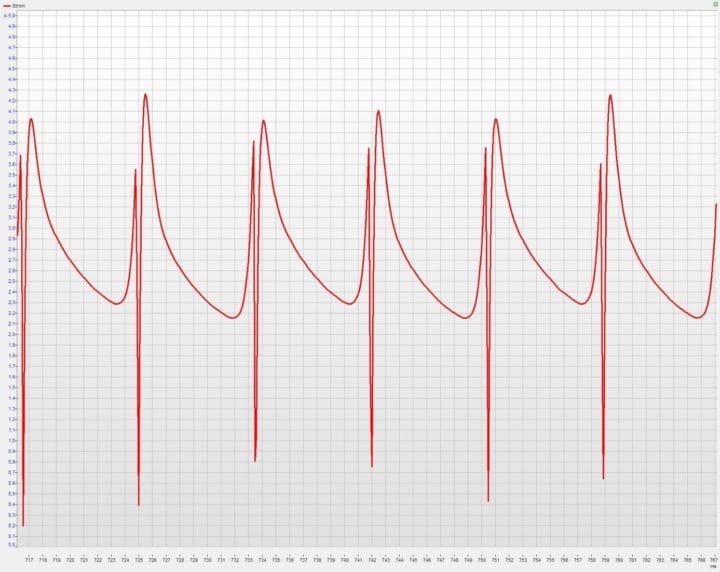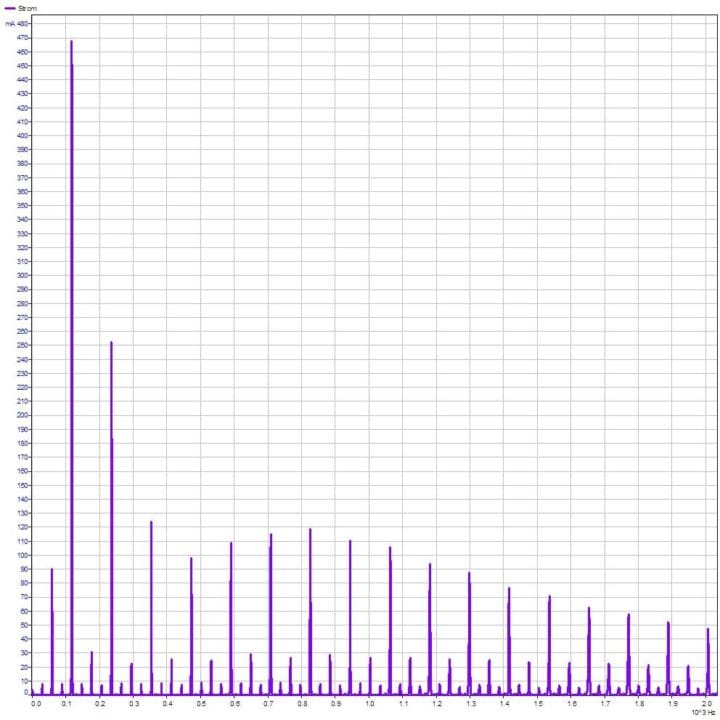For the testing of these e-drives, we implemented the data acquisition solution and evaluation for a large German automotive supplier. Power consumption and speed are relevant to evaluating the efficiency of electromechanical systems. Since the motors are permanently installed into vehicle body parts, often only the electrical current and voltage signals are all that’s available for quality testing.
Using the Current Signal to Determine Motor Speed
In a classic DC motor, the mechanical commutator leads to a brief drop in the current curve when poles are reversed. Depending on the design and number of poles of the motor, the quantity of current dips corresponds to one revolution. This model is also reflected in the current curve of brushless motors with electronic commutation.
Figure 1 demonstrates the current curve of a motor over time. The current pictured here was measured with a Q.bloxx XL A107 I/O module and a shunt. The current drops visible in this example occur during commutation at intervals of 8.4 ms.


Accordingly, the spectrum of the current curve (Figure 2) shows its maximum occurs at 119 Hz. Assuming 3 commutations per revolution, this corresponds to a speed of 2380 revolutions per minute.
The spectrum can be performed both online and offline by Q.series X controllers. In this way, the engine speed can be determined continuously and live on the test bench using the current signal. The necessary configuration is performed in just a few steps.
Quick-and-Easy Configuration on the Test Bench
The FFT function of the Q.series X controller offers, among other things, the possibility to evaluate the maximum of a spectrum within a selected frequency band by magnitude and frequency. The frequency of the maximum corresponds to the fundamental wave and is divided by the number of poles and multiplied by 60 to give the speed in revolutions per minute (rpm). Also, the current is used to detect whether the motor is in operation and whether the electrical power can be calculated.

This edge computing allows the motor speed to be determined without a separate computer.
Depending on the test bench configuration, data can now be transferred to the system control, e.g., via EtherCAT or visualized within GI.bench on the test bench PC or over the local network.
Simply Powerful Visualization
With GI.bench, you can create custom dashboards for visualization. Figure 4 shows the speed and power in the upper chart. When the motor is loaded, the speed decreases (green curve), while the power consumed increases (grey curve). Also, the current spectrum (blue), the current trace (red), and the parameters (table) are displayed numerically in this interface.

For references, demo programs and questions you can always contact us at info@gantner-instruments.com.
More articles
Q.series X A192
The Multifunction Module when Flexibility and the Highest Performance Matters Most
Read more...One-Click Cloud Connectivity – Real-Time DAQ in the Cloud
Historically, connecting your data acquisition (DAQ) system to the cloud involved complex networking setups, manual configurations, and tedious coding. With GI.bench, cloud integration is now seamless—pair your controller to GI.cloud with one click, making secure, remote data access easier than ever before.
Read more...Historic Ship, Modern Protection: Real-Time Force Monitoring Stabilizes Sweden’s Vasa Warship
The Vasa Museum in Stockholm houses Vasa, a 17th-century Swedish warship raised from the seabed in 1961. Almost completely preserved, she is both a cultural icon and a full-scale research platform for naval architecture, materials science, and maritime archaeology. But preserving a 400-year-old oak hull on land poses a critical structural challenge: without buoyancy, the ship’s weight is carried through discrete support points, and slow deformation has already been detected. To protect Vasa for future generations, the museum is replacing the original display cradle with an adjustable steel support system equipped with a real-time force monitoring and long-term structural health monitoring (SHM) solution.
Read more...IPERMON Workshop
Improved photovoltaic (PV) system reliability and lifetime output can be safeguarded by advanced performance monitoring solutions integrated with novel data-analytic features and leverage interoperable communicative capabilities.
Read more...